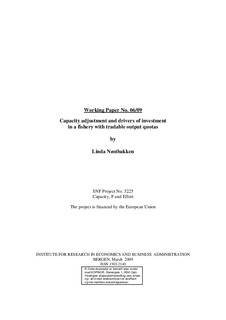| dc.description.abstract | In this study, I analyse what drives investment and capital development, and hence the development of fishing capacity in a well-managed fishery. An empirical analysis of drivers of firm-level investment in the Norwegian purse seine fishery is conducted. The industry is regulated by tradable production quotas that entitles the holder to a certain share of the total allowable catches of various pelagic species. Considerable investment in physical capital has taken place in the industry over the last decade, and the fleet has realised large resource rents. Both quotas and physical capital are crucial to the operation of the firm. For this reason a multiple capital good model is used in the analysis. The empirical results suggest that few economic variables significantly affect firm-level investment in the fishery. Firm-specific effects are, however, found to be important determinants of investment, particularly in quota. Furthermore, the empirical results indicate that when introducing transferrable quotas, auctioning may be superior to grandfathering, as firms otherwise may not take the full opportunity cost of the quota into account. | en |
